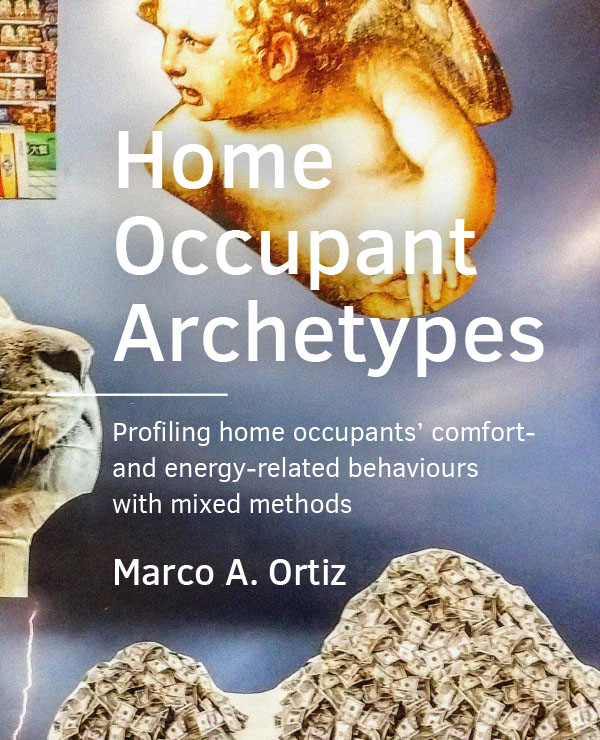Using focus groups data to finalize the Archetypes
Substantiation of Home Occupant Archetypes with the Use of Generative Techniques: Analysis and Results of Focus Groups
DOI:
https://doi.org/10.7480/abe.2019.13.4159Keywords:
energy use, home, profiles, archetypes, generative techniquesAbstract
A previous study clustered home occupants into archetypes with a questionnaire. This study uses qualitative methods to strengthen those previously-found archetypes with data pertaining to the participants’ home experiences. Focus groups were carried out where generative activities were conducted involving the generation of collages. The first activity dealt with the expression of ‘meaning of energy use at home’ and the second one with the ‘ideal home experience’. Analyses were done with content and thematic analysis. Codes were drawn from the data and were assimilated through an affinity diagram. The diagram produced two categories: building themes and human themes, along with five sub-categories (home, financial, energy, psychological, and behavioural aspects). The outcome shows that each archetype expresses needs and meanings of an ideal home experience and energy use differently from each other. The results provide evidence that generative techniques can be used in energy research. In this case, to validate and substantiate the quantitative archetypes previously produced with a questionnaire. Interpretive knowledge in energy research allows for a better understanding of occupants’ differing behavioural patterns in regards to energy use and comfort. It allows customizing interventions to the archetypes’ specific needs to decrease energy consumption while maintaining comfort.
References
Aune, M., Ryghaug, M., & Godbolt, Å. L. (2011). Comfort, consciousness and costs—transitions in Norwegian energy culture 1991–2010. Proceedings of the Energy Efficiency First: The Foundation of a Low-Carbon Society, ECEEE
Bluyssen, P. M. (2009). The Indoor Environment Handbook: How to Make Buildings Healthy and Comfortable: Earthscan.
Bluyssen, P. M. (2014). The Healthy Indoor Environment: How to Assess Occupants’ Wellbeing in Buildings: Routledge.
Boddy, C. R. (2007). Projective techniques in Taiwan and Asia-Pacific market research. Qualitative Market Research: An International Journal, 10(1), pp. 48-62.
Bogner, A., Littig, B., & Menz, W. (2009). Interviewing experts: Springer.
Crowe, M., Inder, M., & Porter, R. (2015). Conducting qualitative research in mental health: Thematic and content analyses. Australian & New Zealand Journal of Psychiatry, 49(7), pp. 616-623.
Dam, R., & Siang, T. (2018). How to Select the Best Idea by the end of an Ideation Session. Retrieved Date Accessed, 2019 from https://www.interaction-design.org/literature/article/how-to-select-the-best-idea-by-the-end-of-an-ideation-session.
Gaffigan, M. E. (2008). Advanced Energy Technologies: Budget Trends and Challenges for DOE’s Energy R&D Program (US Government Accountability Office. United States Government Accountability Office
Hershkowitz, R., Schwarz, B. B., & Dreyfus, T. (2001). Abstraction in context: Epistemic actions. Journal for Research in Mathematics Education, pp. 195-222.
Hibbard, S. (2003). A critique of Lilienfeld et al.’s (2000)” The Scientific Status of Projective Techniques”. Journal of Personality Assessment, 80(3), pp. 260-271.
Hong, T., D’Oca, S., Turner, W. J., & Taylor-Lange, S. C. (2015). An ontology to represent energy-related occupant behavior in buildings. Part I: Introduction to the DNAs framework. Building and Environment, 92, pp. 764-777.
Hong, T., Taylor-Lange, S. C., D’Oca, S., Yan, D., & Corgnati, S. P. (2016). Advances in research and applications of energy-related occupant behavior in buildings. Energy and Buildings, 116, pp. 694-702.
Majcen, D., Itard, L., & Visscher, H. (2013). Theoretical vs. actual energy consumption of labelled dwellings in the Netherlands: Discrepancies and policy implications. Energy Policy, 54, pp. 125-136.
Norušis, M. J. (2012). IBM SPSS statistics 19 statistical procedures companion: Prentice Hall.
Ortiz, M. A., & Bluyssen, P. M. (2018). Proof-of-concept of a questionnaire to understand occupants’ comfort and energy behaviours: First results on home occupant archetypes. Building and Environment, 134, pp. 47-58.
Ortiz, M. A., & Bluyssen, P. M. (2019). Developing home occupant archetypes: First results of mixed-methods study to understand occupant comfort behaviours and energy use in homes. Building and Environment
Ortiz, M. A., Kurvers, S. R., & Bluyssen, P. M. (2017). A review of comfort, health, and energy use: understanding daily energy use and wellbeing for the development of a new approach to study comfort. Energy and Buildings, 152, pp. 323-335.
Polkinghorne, M., & Arnold, A. (2014). A six step guide to using recursive abstraction applied to the qualitative analysis of interview data. Discussion paper. Poole, United Kingdom: Bournemouth University.
Sanders, E., & William, C. (2003). Harnessing people’s creativity: Ideation and expression through visual communication Focus Groups (pp. 147-158): CRC Press.
Sanders, E. B. N., & Stappers, P. J. (2008). Co-creation and the new landscapes of design. CoDesign, 4, pp. 5-18.
Sovacool, B. K. (2014). What are we doing here? Analyzing fifteen years of energy scholarship and proposing a social science research agenda. Energy Research & Social Science, 1, pp. 1-29.
Stappers, P. J., & Sanders, E. B. (2003). Generative tools for context mapping: tuning the tools. Design and Emotion. London: Taylor & Francis.
Tsemekidi Tzeiranaki, S., Bertoldi, P., Diluiso, F., Castellazzi, L., Economidou, M., Labanca, N., . . . Zangheri, P. (2019). Analysis of the EU Residential Energy Consumption: Trends and Determinants. Energies, 12(6), p 1065.
Vaughn, S., Schumm, J. S., & Sinagub, J. M. (1996). Focus group interviews in education and psychology. Sage.
Vaismoradi, M., Turunen, H., & Bondas, T. (2013). Content analysis and thematic analysis: Implications for conducting a qualitative descriptive study. Nursing & health sciences, 15(3), pp. 398-405.
Visser, F. S., Stappers, P. J., Van der Lugt, R., & Sanders, E. B. (2005). Contextmapping: experiences from practice. CoDesign, 1(2), pp. 119-149.


